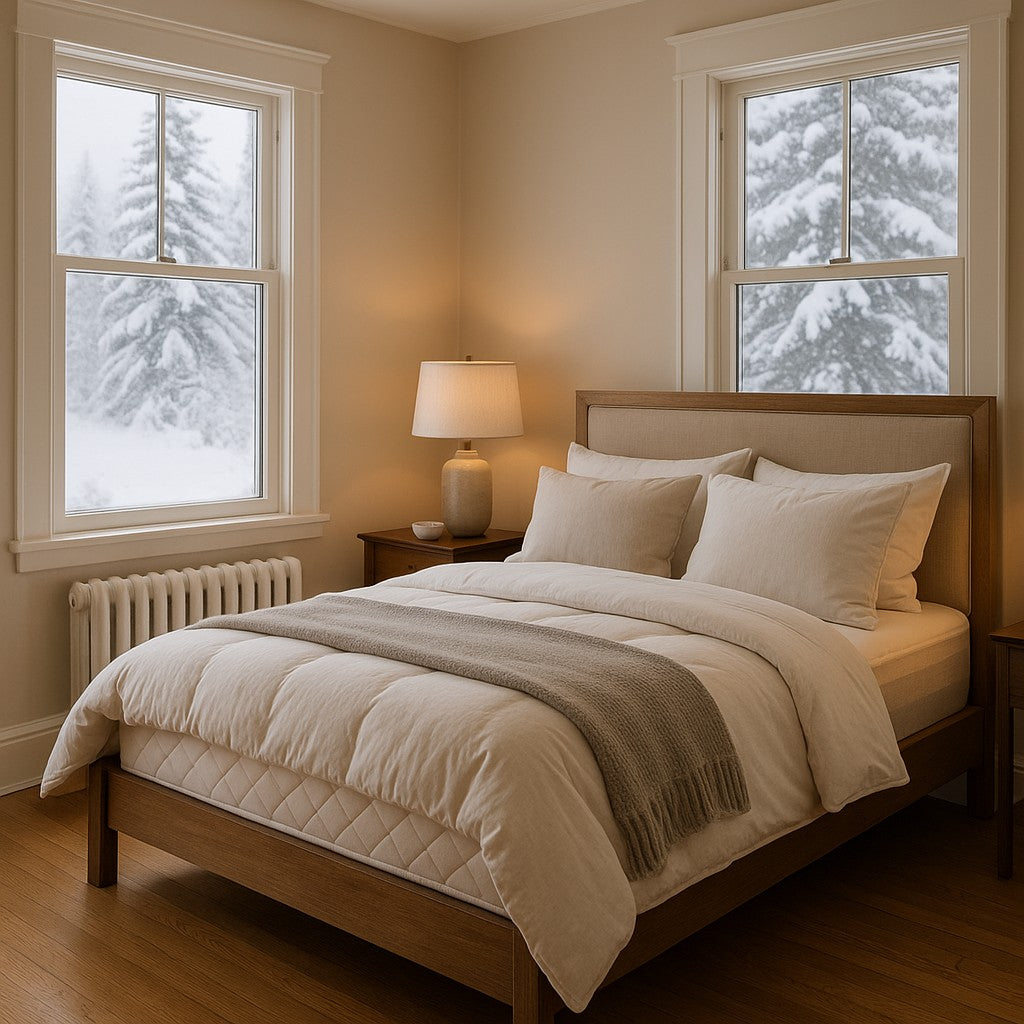In This Article:

Quick Answers
What temperature for sleeping? 15-19°C (60-67°F). Cooler than most people expect. Your body temperature drops when you sleep, and a cool room helps that happen.
How much sleep do I need? 7-9 hours for adults. But quality matters too - uninterrupted sleep is better than 9 hours of tossing and turning.
How do I fall asleep faster? Same bedtime every night. No screens an hour before bed. Keep it cool and dark. And honestly, a supportive mattress helps more than people realize.
Why Canadians Struggle to Sleep Well in Winter
Every November, the same thing happens across Ontario. Thermostats get cranked up, bedroom windows stay sealed shut, and sleep quality takes a hit. If you've noticed you're sleeping worse once the cold weather arrives, you're not alone. A 2026 study from the University of British Columbia found that 67% of Canadians report worse sleep quality during winter months.
But here's the thing: it's usually not the cold that's the problem. It's how we respond to it.
The Ideal Sleep Temperature (It's Lower Than You Think)
The ideal sleep temperature is between 15-19°C (60-67°F). That's cooler than most Canadian homes in winter, where thermostats typically sit around 21°C or higher. Your body temperature naturally drops as you fall asleep, and a cool room helps that process along. When your bedroom is too warm, your body has to work harder to regulate itself, which disrupts your sleep cycles.
Research from the National Sleep Foundation shows that even a 2-3 degree increase above the optimal sleeping temperature can reduce deep sleep by up to 20%. Deep sleep is when your body repairs tissue, builds bone and muscle, and strengthens your immune system. Less deep sleep means waking up feeling unrested, even after eight hours in bed.
The Ontario Winter Heating Dilemma
Here's where it gets tricky for us in the Brantford area. Natural gas prices rose 18% in Ontario between 2026 and 2026, and nobody wants to pay more than necessary to heat their home. So we close vents, lower thermostats, or do the opposite and blast the heat to stay comfortable. Neither approach helps your sleep.
The best room temperature for sleep is consistent. Fluctuating between too cold and too hot throughout the night is worse than being slightly outside the optimal range. If you're turning the heat down dramatically at night to save money, your body spends the early morning hours trying to warm up instead of completing its final REM cycle.
What Actually Works
Instead of fighting your thermostat, work with your bedding:
- Layer your bedding. A good down duvet with a lighter blanket underneath lets you adjust warmth without changing room temperature.
- Choose breathable materials. Cotton or bamboo sheets wick moisture away. Flannel feels cozy but can trap heat and make you sweat.
- Consider your mattress. Memory foam holds body heat. If you're sleeping hot, a hybrid mattress with coils allows better airflow.
The Humidity Problem
Canadian winters bring another sleep enemy: dry air. Forced-air heating pulls moisture out of your home, dropping indoor humidity to 20-30% when the healthy range is 40-50%. Low humidity causes:
- Dry nasal passages that lead to snoring
- Scratchy throat that wakes you up
- Itchy skin that makes it hard to get comfortable
- Static electricity (ever been shocked by your own pillow?)
A bedroom humidifier helps, but placement matters. Keep it away from your bed and any electronics. And clean it weekly, or you're just pumping mold spores into the air.
Daylight and Your Sleep Schedule
Brantford gets about 8.5 hours of daylight in late December, compared to 15.5 hours in June. That shift affects your circadian rhythm more than most people realize. Less sunlight means less natural cue for your body to stay alert during the day, which leads to:
- Feeling tired earlier in the evening
- Trouble waking up in the morning
- More time in bed but lower quality sleep
The fix isn't sleeping more. It's getting bright light exposure in the morning, even if that means a light therapy lamp. And keeping your bedroom completely dark at night. Blackout curtains do double duty in winter: blocking street lights and adding an extra layer of insulation at the window.
Your Mattress Works Harder in Winter
Cold temperatures make foam denser. That's basic physics, but it has real effects on how your mattress feels. A mattress that felt perfect in September might feel firmer in January, especially if your bedroom gets cold during the day while you're at work.
This is one reason why adjustable bed bases become popular in winter. Being able to raise your head slightly helps with breathing (important when dry air causes congestion) and takes pressure off your lower back if your mattress feels firmer than usual.
When to Consider a New Mattress
If you've been sleeping poorly every winter for years and nothing else seems to help, your mattress might be the issue. The average mattress lasts 7-10 years, but that assumes you're not dealing with:
- Visible sagging or indentations
- Springs you can feel through the surface
- Waking up stiff or sore consistently
- Better sleep anywhere except your own bed
We see a lot of customers in January who finally decide to do something about their sleep after struggling through the holidays. There's something about starting a new year exhausted that motivates people to make changes.
What We Recommend
For Canadian winters specifically, we usually point people toward:
- Hybrid mattresses for better temperature regulation and consistent feel year-round
- Natural latex options like Natura mattresses that don't harden in cold
- Temperature-neutral foams that respond to body heat, not room temperature
Stop by our store on West Street in Brantford and try a few options. We've been helping people sleep better through Ontario winters since 1987, and we're happy to share what we've learned.
Mattress Miracle is located at 441½ West Street, Brantford. Same-day delivery available in Brant County.

